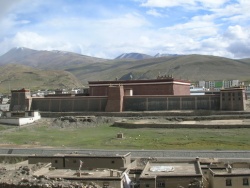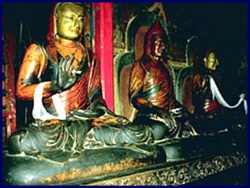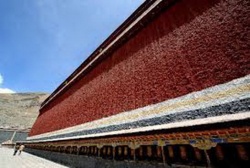Difference between revisions of "Sakya Monastery"
| Line 16: | Line 16: | ||
[[Sakya]] [[Monastery]], also known as [[dPal Sa skya]] or [[Pel Sakya]] ("White [[Earth]]" or "Pale [[Earth]]") is a [[Buddhist Monastery]] situated 25 km [[southeast]] of a bridge which is about 127 km [[west]] of [[Shigatse]] on the road to [[Tingri]] [[In Tibet]]. | [[Sakya]] [[Monastery]], also known as [[dPal Sa skya]] or [[Pel Sakya]] ("White [[Earth]]" or "Pale [[Earth]]") is a [[Buddhist Monastery]] situated 25 km [[southeast]] of a bridge which is about 127 km [[west]] of [[Shigatse]] on the road to [[Tingri]] [[In Tibet]]. | ||
| − | The seat of the [[Sakya]] or [[Sakyapa school]] of [[Tibetan Buddhism]], it was founded in 1073, by [[Konchok Gyelpo]] (1034-1102), originally a [[Nyingmapa | + | The seat of the [[Sakya]] or [[Sakyapa school]] of [[Tibetan Buddhism]], it was founded in 1073, by [[Konchok Gyelpo]] (1034-1102), originally a [[Nyingmapa Monk]] of the powerful [[Noble]] [[family]] of the [[Tsang]] and became the first [[Sakya Trizin]]. |
| − | Its {{Wiki|Mongolian}} [[architecture]] is quite different from that of [[temples]] in [[Lhasa]] and [[Yarlung]]. The only surviving [[ancient]] building is the [[Lhakang]] | + | Its powerful [[abbots]] governed [[Tibet]] during the whole of the 13th century after the downfall of the [[kings]] until they were eclipsed by the rise of the new [[Gelukpa school]] of [[Tibetan Buddhism]]. |
| + | |||
| + | Its {{Wiki|Mongolian}} [[architecture]] is quite different from that of [[temples]] in [[Lhasa]] and [[Yarlung]]. | ||
| + | |||
| + | The only surviving [[ancient]] building is the [[Lhakang Chempo]] or [[Sibgon Trulpa]]. | ||
| + | |||
| + | Originally a [[cave]] in the mountainside, it was built in 1268 by [[Ponchen Sakya Sangpo]] in 1268 and restored in the 16th century. It contains some of the most magnificent surviving artwork in all of [[Tibet]], which appears not to have been damaged in recent Times. | ||
| + | |||
| + | The [[Gompa]] grounds cover more than 18,000 square metres, while the huge main hall covers some 6,000 square metres. | ||
Most of the buildings of the [[Monastery]] are [[in ruins]], because they were destroyed during the {{Wiki|Cultural Revolution}}. | Most of the buildings of the [[Monastery]] are [[in ruins]], because they were destroyed during the {{Wiki|Cultural Revolution}}. | ||
| − | Das Sharat | + | |
| + | [[Das Sharat Chandra]] writes: | ||
[[File:Monastery_tib3.jpg|thumb|250px|]] | [[File:Monastery_tib3.jpg|thumb|250px|]] | ||
| − | |||
| − | There is also preserved in this [[temple]] a [[Conch]] | + | As to the great library of [[Sakya]], it is on shelves along the walls of the great hall of the [[Lhakhang chen-po]]. |
| − | A huge library of as many as 84,000 scrolls were found sealed up in a wall 60 | + | |
| − | [[Sakya]] [[Monastery]] in [[ | + | There are preserved here many volumes written in {{Wiki|gold}} letters; the pages are six feet long by eighteen inches in breadth. |
| + | |||
| + | In the margin of each page are illuminations, and the first four volumes have in them pictures of the thousand [[Buddhas]]. These [[Books]] are [[bound]] in {{Wiki|iron}}. | ||
| + | |||
| + | They were prepared under orders of the [[Emperor]] [[Kublai Khan]], and presented to the [[Phagpa Lama]] on his second visit to {{Wiki|Beijing}}. | ||
| + | |||
| + | There is also preserved in this [[temple]] a [[Conch shell]] with whorls turning from left to Right in [[Tibetan]], [[Ya chyü dungkar]] ], a {{Wiki|present}} from [[Wikipedia:Kublai Khan|Kublai]] to [[Phagpa]]. | ||
| + | |||
| + | It is only blown by the [[lamas]] when the request is accompanied by a {{Wiki|present}} of seven ounces of {{Wiki|silver}}; but to blow it, or have it blown, is held to be an act of great [[Merit]]." | ||
| + | |||
| + | |||
| + | A huge library of as many as 84,000 scrolls were found sealed up in a wall 60 meters long and 10 meters high at [[Sakya Monastery]] in 2003. | ||
| + | |||
| + | It is expected that most of them will prove to be [[Buddhist]] [[scriptures]] although they may well also include works of {{Wiki|literature}}, and on history, [[philosophy]], {{Wiki|astronomy}}, [[mathematics]] and [[Art]]. | ||
| + | |||
| + | They are [[Thought]] to have remained untouched for hundreds of years. | ||
| + | |||
| + | They are being examined by the [[Tibetan]] {{Wiki|Academy}} of {{Wiki|Social Sciences}}. | ||
| + | [[Sakya Monastery in India]] | ||
| + | |||
| + | The current [[Sakya Trizin]], [[throne holder of the Sakyapa]] went into exile in [[India]] in 1959 following the [[Wikipedia:Battle of Chamdo|Chinese invasion]] of [[Tibet]]. | ||
| + | |||
| + | He has long lived in [[Dehra Dun]] in the foothills of the [[Western]] [[Himalayas]], where the [[Sakya Monastery]] was reestablished, | ||
| + | |||
| + | with a number of senior [[Monks]] and [[scholars]], who also escaped from [[Tibet]], joining the new [[Monastery]] and providing continuity to [[Sakya traditions]]. | ||
| + | |||
| + | These [[Monks]] and [[scholars]] saved a number of original scrolls from the original [[Sakya Monastery In Tibet]] and smuggled them to [[India]] for ssfekeeping. | ||
| + | |||
| + | The [[Sakya Trizin]] and his followers have established several {{Wiki|institutions}} in and around the {{Wiki|Dehradun}} area, [[including]] a charitable hospital, a [[monastic college]] and a [[nunnery]]. | ||
| + | |||
| + | Like all leaders of the [[Sakya school]], the current [[Sakya Trizin]] is [[married]]. He has two sons, and the younger one, [[Dungsey Gyana Vajra]], born 5 July 1979 in [[Dehra Dun]], is director of the [[Sakya Monastery]] [[constructed]] in [[Dehra Dun]]. | ||
| + | |||
| + | [[Sakya Monastery]] was built at an [[auspicious]] location prophesied by the great [[Indian master]] [[Atisha]], who foresaw that [[emanations]] of [[Mahakala]], [[Manjushri]], [[Vajrapani]], and [[Avalokiteshvara]] would take [[birth]] at this place and perform great [[Activities]] for the [[benefit]] of The [[Dharma]] and all [[beings]]. | ||
| − | |||
| − | |||
[[File:Sakya_Monastery45.jpg|thumb|250px|]] | [[File:Sakya_Monastery45.jpg|thumb|250px|]] | ||
| − | In 1268 [[Chogyal Phagpa]], the fifth of the five founders of the [[Sakya | + | In 1268 [[Chogyal Phagpa]], the fifth of the five founders of the [[Sakya Order]], greatly expanded the [[Monastery]], and over the centuries it has grown into a complex of hundreds of [[temples]], [[shrines]], and [[monastic]] residences. |
| + | |||
| + | The buildings contain thousands of [[Statues]], paintings, murals, [[Stupas]], [[mandalas]], and other {{Wiki|holy}} [[objects]], as well as libraries of [[scriptures]] in [[Tibetan]], {{Wiki|Chinese}}, {{Wiki|Mongolian}}, and [[Sanskrit]] piled from floor to ceiling. | ||
| + | |||
| + | the {{Wiki|holy}} [[objects]] in the [[Monastery]] are the lifesize statue of [[Manjushri]] that spoke to [[Sakya Pandita]] to assist him during a famous [[debate]]; | ||
| + | |||
| + | a small statue of [[Tara]] that was [[Atisha’s]] personal [[Meditation object]]; and the [[Conch shell]] blown by The [[Buddha]]’s [[disciples]] to summon [[Monks]] to his teachings. | ||
| + | |||
| + | [[Sakya Monastery]] became a citadel of {{Wiki|learning}} and the fount from which the ten major and minor [[sciences]] were introduced to [[Tibet]] from [[India]]. | ||
| + | |||
| + | The [[Fame]] of [[Sakya Monastery]] and its [[teachers]] reached the [[ears]] of [[Kublai Khan]] and {{Wiki|Godan Khan}}, the {{Wiki|Mongol}} rulers of [[China]]. | ||
| + | |||
| + | They invited [[Sakya Pandita]], who was the fourth of the five founders, and [[Chogyal Phagpa]] to their court. Through the teachings of these two great [[masters]], [[Vajrayana Buddhism]] reached [[China]]. | ||
| − | + | Under the [[Leadership]] of [[His Holiness]] [[Sakya Trizin]], major portions of [[Sakya Monastery]] that were destroyed during the {{Wiki|Cultural Revolution}} have been renovated, and [[religious]] [[Activities]] still continue there as they have for nearly a thousand years. | |
| − | + | For additional [[Information]], see The [[Sakya Tradition]]. | |
</poem> | </poem> | ||
{{W}} | {{W}} | ||
[[Category:Buddhist Terms]] | [[Category:Buddhist Terms]] | ||
[[Category:Sakya Monastery]] | [[Category:Sakya Monastery]] | ||
Latest revision as of 09:23, 8 April 2016
Sakya Monastery was built in 1073 by Khonchog Gyalpo.
It is located in the city of Sakya, in the Tibetan region of Tsang, about one hundred miles north of the border between Tibet and Nepal.
The region is unique for its gray (kya) Earth (sa), hence the Name Sakya.
From 1073 until 1959, this Monastery served as the seat of the Sakya Order and of the Sakya Trizins who are the Spiritual leaders of the Order.
Sakya Monastery, also known as dPal Sa skya or Pel Sakya ("White Earth" or "Pale Earth") is a Buddhist Monastery situated 25 km southeast of a bridge which is about 127 km west of Shigatse on the road to Tingri In Tibet.
The seat of the Sakya or Sakyapa school of Tibetan Buddhism, it was founded in 1073, by Konchok Gyelpo (1034-1102), originally a Nyingmapa Monk of the powerful Noble family of the Tsang and became the first Sakya Trizin.
Its powerful abbots governed Tibet during the whole of the 13th century after the downfall of the kings until they were eclipsed by the rise of the new Gelukpa school of Tibetan Buddhism.
Its Mongolian architecture is quite different from that of temples in Lhasa and Yarlung.
The only surviving ancient building is the Lhakang Chempo or Sibgon Trulpa.
Originally a cave in the mountainside, it was built in 1268 by Ponchen Sakya Sangpo in 1268 and restored in the 16th century. It contains some of the most magnificent surviving artwork in all of Tibet, which appears not to have been damaged in recent Times.
The Gompa grounds cover more than 18,000 square metres, while the huge main hall covers some 6,000 square metres.
Most of the buildings of the Monastery are in ruins, because they were destroyed during the Cultural Revolution.
Das Sharat Chandra writes:
As to the great library of Sakya, it is on shelves along the walls of the great hall of the Lhakhang chen-po.
There are preserved here many volumes written in gold letters; the pages are six feet long by eighteen inches in breadth.
In the margin of each page are illuminations, and the first four volumes have in them pictures of the thousand Buddhas. These Books are bound in iron.
They were prepared under orders of the Emperor Kublai Khan, and presented to the Phagpa Lama on his second visit to Beijing.
There is also preserved in this temple a Conch shell with whorls turning from left to Right in Tibetan, Ya chyü dungkar ], a present from Kublai to Phagpa.
It is only blown by the lamas when the request is accompanied by a present of seven ounces of silver; but to blow it, or have it blown, is held to be an act of great Merit."
A huge library of as many as 84,000 scrolls were found sealed up in a wall 60 meters long and 10 meters high at Sakya Monastery in 2003.
It is expected that most of them will prove to be Buddhist scriptures although they may well also include works of literature, and on history, philosophy, astronomy, mathematics and Art.
They are Thought to have remained untouched for hundreds of years.
They are being examined by the Tibetan Academy of Social Sciences.
Sakya Monastery in India
The current Sakya Trizin, throne holder of the Sakyapa went into exile in India in 1959 following the Chinese invasion of Tibet.
He has long lived in Dehra Dun in the foothills of the Western Himalayas, where the Sakya Monastery was reestablished,
with a number of senior Monks and scholars, who also escaped from Tibet, joining the new Monastery and providing continuity to Sakya traditions.
These Monks and scholars saved a number of original scrolls from the original Sakya Monastery In Tibet and smuggled them to India for ssfekeeping.
The Sakya Trizin and his followers have established several institutions in and around the Dehradun area, including a charitable hospital, a monastic college and a nunnery.
Like all leaders of the Sakya school, the current Sakya Trizin is married. He has two sons, and the younger one, Dungsey Gyana Vajra, born 5 July 1979 in Dehra Dun, is director of the Sakya Monastery constructed in Dehra Dun.
Sakya Monastery was built at an auspicious location prophesied by the great Indian master Atisha, who foresaw that emanations of Mahakala, Manjushri, Vajrapani, and Avalokiteshvara would take birth at this place and perform great Activities for the benefit of The Dharma and all beings.
In 1268 Chogyal Phagpa, the fifth of the five founders of the Sakya Order, greatly expanded the Monastery, and over the centuries it has grown into a complex of hundreds of temples, shrines, and monastic residences.
The buildings contain thousands of Statues, paintings, murals, Stupas, mandalas, and other holy objects, as well as libraries of scriptures in Tibetan, Chinese, Mongolian, and Sanskrit piled from floor to ceiling.
the holy objects in the Monastery are the lifesize statue of Manjushri that spoke to Sakya Pandita to assist him during a famous debate;
a small statue of Tara that was Atisha’s personal Meditation object; and the Conch shell blown by The Buddha’s disciples to summon Monks to his teachings.
Sakya Monastery became a citadel of learning and the fount from which the ten major and minor sciences were introduced to Tibet from India.
The Fame of Sakya Monastery and its teachers reached the ears of Kublai Khan and Godan Khan, the Mongol rulers of China.
They invited Sakya Pandita, who was the fourth of the five founders, and Chogyal Phagpa to their court. Through the teachings of these two great masters, Vajrayana Buddhism reached China.
Under the Leadership of His Holiness Sakya Trizin, major portions of Sakya Monastery that were destroyed during the Cultural Revolution have been renovated, and religious Activities still continue there as they have for nearly a thousand years.
For additional Information, see The Sakya Tradition.


